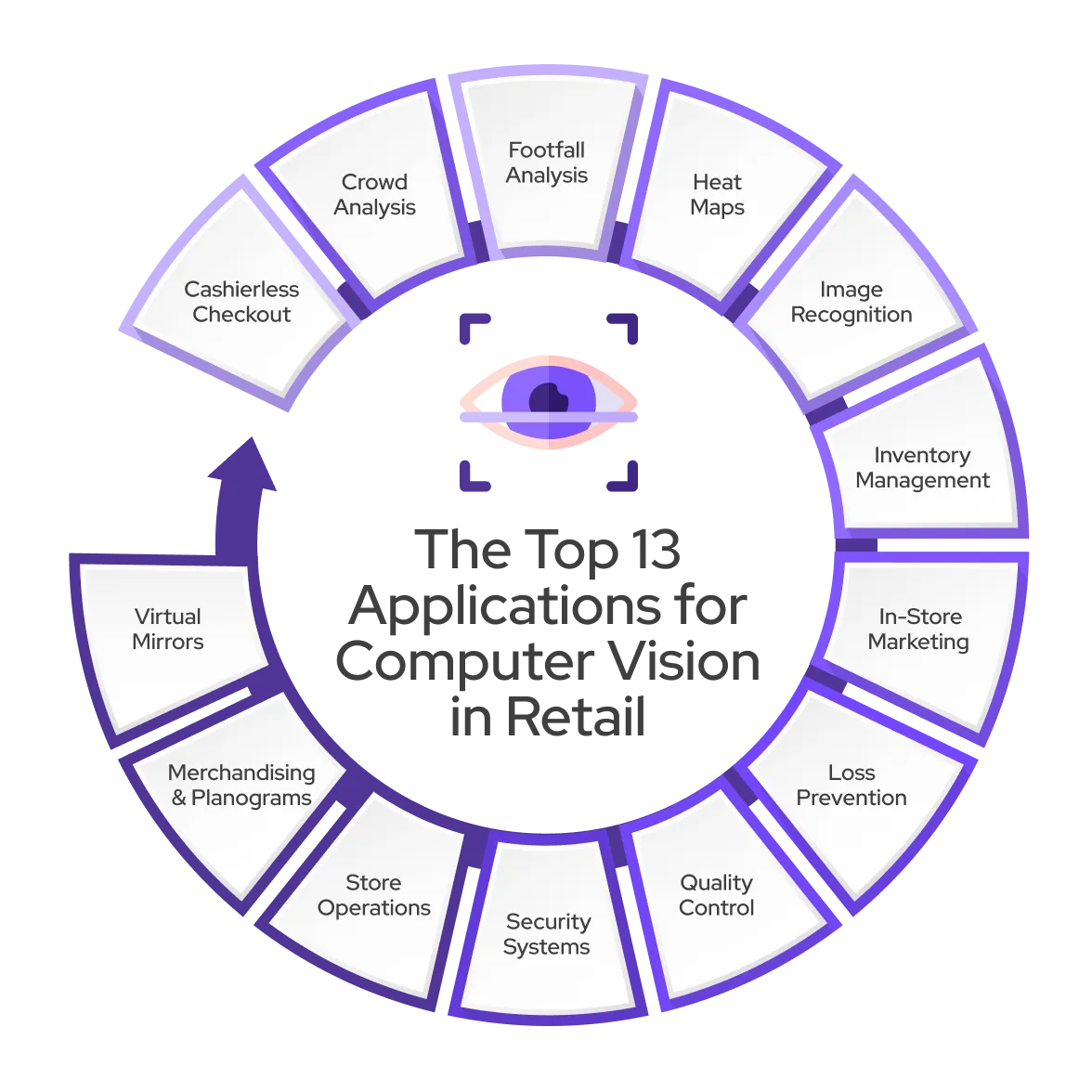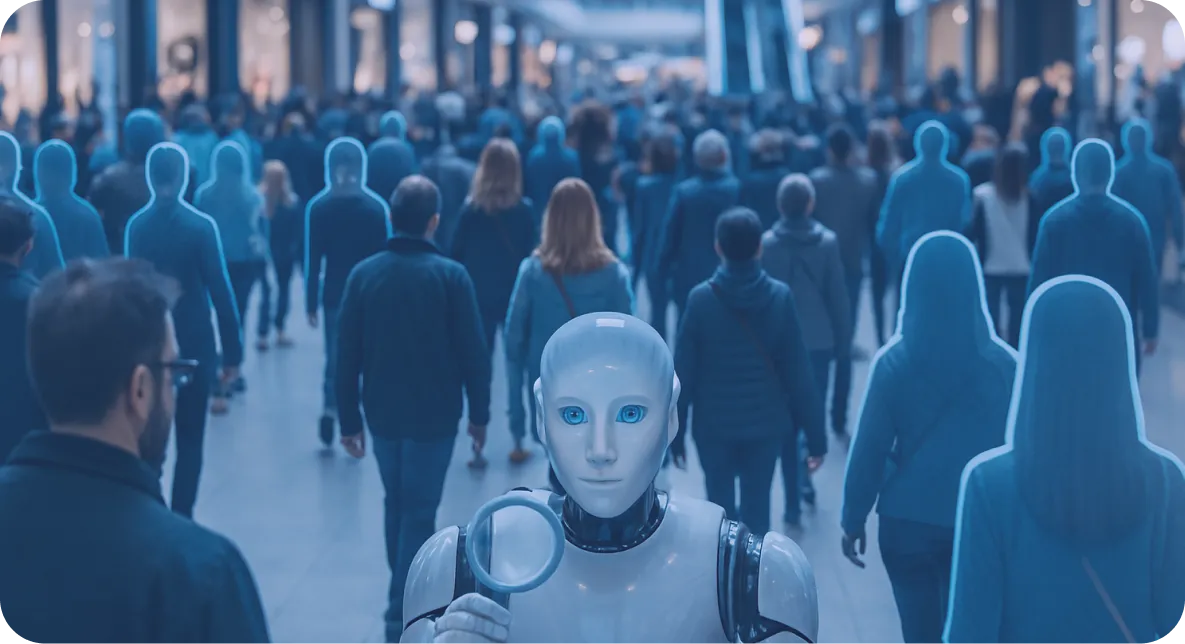Discover how computer vision in retail is changing the way companies do business. The modern AI vision system enhances customer satisfaction, optimizes store layouts, and checks inventory levels in real time. But what are these new AI-powered systems, and how are they used in the retail sector? Below, we define the technology and list the top 13 applications for computer vision in retail.

Introduction to Retail Computer Vision
Computer vision is a branch of artificial intelligence that enables computers to comprehend and analyze a visual setting. It entails training systems to examine, evaluate, and derive conclusions from images and video streams. Computer vision enjoys extensive use in many economic sectors and shows remarkable potential in the retail industry.
The Top 13 Applications for Computer Vision in Retail
Computer vision solutions have many applications in a retail environment. The latest AI retail solutions improve productivity for merchants and enrich the customer experience for shoppers. Whether customers prefer online shopping or visiting physical stores, they provide invaluable data to retailers. But how are companies using retail AI today? Let’s explore the top 13 applications for computer vision in retail to find out!

1. Cashierless Checkout
Automated checkout systems and cashier-free retail stores have increased in popularity for over two decades. The latest systems leverage computer vision cameras and deep learning to recognize product prices and compute the total cost of items a customer selects.
Customers and merchants both strive for a smooth, hassle-free shopping process, with computer vision as the core technology enabling this transformation. Conventional point-of-sale systems suffer from inefficiencies, including lengthy lines, manual barcode scanning, and human mistakes. AI computer vision technology eliminates these obstacles, allowing cashierless shops to revolutionize retail operations with greater reliability and precision.

2. Crowd Analysis
Computer vision accurately tallies retail visitors and analyzes shopper behavior. For example, vendors can monitor customer movements within a brick-and-mortar establishment, measure the duration of interaction with each item, and ensure adherence to all established store guidelines.

3. Footfall Analysis
AI computer vision systems identify foot traffic and behavioral trends inside and outside a store. AI vision measures the conversion rate of passing visitors and maps customer movement trajectories throughout a retail space. Merchants can then determine which marketing campaigns attract attention or discourage potential buyers.

4. Heat Maps
Retail heat maps provide insights into store efficiency and shopper interactions. Heat maps are color-coded grids where individual data points in the grids are visually represented through varying shades.
Heat mapping technology utilizes live imaging to track motion and assign colors corresponding to foot traffic density in different store sections. Large corporations use heat maps to analyze customer behavior, evaluate fresh merchandising tactics, and refine store configurations. Given the growing adoption of this technology in retail and its many applications, interest appears poised to expand.

5. Image Recognition
The excitement surrounding image recognition in retail has revolved around augmented reality (AR) and consumer insights. However, there remains a vast reservoir of unexplored possibilities in harnessing image recognition to improve services linked to what shoppers observe in brick-and-mortar shops.
In the coming years, consumers will fully embrace image recognition technology to elevate in-store assistance and streamline product discovery. This innovation will allow shoppers to scan items using their phones to retrieve real-time stock availability instantly. The phone app could recommend comparable merchandise, motivate buyers to finalize their purchase, and alert a store associate to deliver the item directly to them.
By enriching the shopping journey, this advancement could preserve sales from customers who typically use their phones to compare prices on the internet.

6. In-Store Marketing
Image recognition in retail augments geofencing, enabling stores to identify specific patrons upon entry and provide them with personalized discounts. Also, shoppers can receive tailored suggestions on potential purchases derived from their past buying patterns.

7. Inventory Management
Beyond automated checkout, consumers also want accurate details regarding the stock status of specific items while navigating an e-commerce platform. Today, most merchants plan to implement computer vision technology to streamline and oversee inventory processes.
With AI-powered inventory cycle audits that use computer vision-powered cameras, retail enterprises can refresh their stock management systems instantaneously, fostering a seamless multi-channel shopping journey.
Since effective inventory oversight is linked to demand projections, analyzing purchasing patterns and timing allows merchants to strategically replenish products in their shops.

8. Loss Prevention
Computer vision algorithms help equip computers with a form of sight that has massive implications for retail shrinkage mitigation. AI vision employs machine learning algorithms to monitor shopper activities, recognize trends, and derive insights from these observations. One of the most prevalent uses of computer vision in loss prevention involves detecting questionable conduct associated with fraudulent purchases and shoplifting.
Computer vision technology has already demonstrated its capacity to curb staff-related theft at point-of-sale terminals by tackling prevalent issues like unauthorized discounts and unscanned items. By identifying each item in the checkout zone and cross-referencing it with the corresponding transaction, computer vision aids in thwarting dishonest employees from misappropriating merchandise.

9. Quality Control
Likewise, computer vision for retail supports quality control by identifying defective or outdated merchandise. Advanced imaging systems analyze packaging and verify expiration dates, eliminating the need for manual inspections, which prove labor-intensive and susceptible to inaccuracies.
By proactively detecting and eliminating unsaleable items, merchants reduce the likelihood of consumer dissatisfaction and possible legal repercussions. When managing perishable goods, computer vision solutions enable retailers to refuse shipments of products with a short remaining lifespan, preventing these items from hitting the shelves and guaranteeing customer well-being.
With computer vision combined with predictive analytics, retailers can examine past and live data on shopper habits, cyclical trends, and outside influences such as climate conditions. Utilizing this innovation, stores can predict market demand with remarkable precision, facilitating more intelligent sourcing strategies while minimizing surplus inventory and product shortages.

10. Security Systems
AI vision detects questionable behavioral trends, such as loitering in an aisle without completing a transaction or repeatedly visiting obscured areas of the store. These computer vision solutions continuously refine themselves, adapting with each encounter and improving their predictive precision over time. This self-evolving characteristic strengthens the system’s reliability and decreases erroneous detections, lowering the chances of mistakenly implicating legitimate shoppers.

11. Merchandising and Planograms
Computer vision frameworks examine store shelves to determine optimal product arrangement and detect whether depleted or misplaced items. For example, big box retailers have deployed shelf-inspecting robots to navigate their brick-and-mortar stores’ aisles, assess pricing accuracy, and identify discrepancies. This innovation significantly reduces the time and effort required from human staff, allowing them to concentrate on tasks like assisting customers.

12. Store Operations
Machine vision applies to several aspects of store operations to minimize reliance on a large human workforce. For example, automated stock control ensures the reliability of the supply network.
A crucial element of computer vision involves refining the shopper’s experience throughout the store environment. Heat mapping leverages computer vision sensors to monitor consumer navigation, detecting densely visited sections, inactive zones, and congestion points. Corporate grocers utilize these heat maps to reconfigure their store arrangements.
For instance, if a featured display fails to attract the expected foot traffic, the heat map’s live insights trigger an instant strategy shift, prompting modifications to signage or merchandise substitutions.
Another computer vision application involves line monitoring. AI camera systems anticipate line lengths and wait durations, allowing shops to deploy personnel more effectively. Various retail and fast-food franchises leverage this innovation to evaluate line congestion and modify workforce distribution at checkout counters in real time.
Computer vision unlocks the automation of other staff responsibilities as well. Embodied AI robots perform a vast array of in-store maintenance tasks, including floor sanitation, monitoring temperatures in refrigeration units, and checking whether promotional signage aligns with ongoing sales.
The latest technology also helps companies maintain compliance. During peak shopping seasons, monitoring occupancy levels remains a vital operational concern. AI cameras positioned at the doors can tally customers automatically, supporting adherence to maximum occupancy laws.

13. Virtual Mirrors
Computer vision integrates seamlessly with augmented reality (AR) to revolutionize the shopping experience with virtual mirrors. This technological convergence works best in the apparel, beauty, and eyewear industries, where appearance and fit remain key considerations. Brick-and-mortar and e-commerce retailers leverage these innovations to streamline the consumer decision-making journey while improving the purchasing experience.
Eyewear companies use computer vision and augmented reality to scan the customers’ facial features and superimpose different eyeglass frames digitally. Virtual try-on experiences produce lifelike visualizations of each frame’s appearance, removing uncertainty and empowering shoppers to make informed online purchasing decisions.
In the beauty industry, companies integrate augmented reality, intelligent mirrors, and mobile applications to enable consumers to apply cosmetics digitally. The software leverages computer vision algorithms to precisely detect facial attributes and generate lifelike simulations. Recent trials have yielded impressive outcomes for major lifestyle and beauty companies.
Intelligent dressing rooms integrated with AI computer vision can identify garments selected for fitting. They subsequently showcase alternative sizes and shades and even propose matching accessories, functioning much like a virtual stylist.
Apart from personal applications, these innovations minimize product returns, a persistent challenge in the retail industry. By refining the precision of digital shopping experiences, computer vision and augmented reality significantly lower the chances of misshipment, reducing return frequencies and related expenses.

Try Cutting-Edge Computer Vision AI From AiFA Labs
Our state-of-the-art Edge Vision AI Platform delivers unparalleled accuracy in object and activity recognition. It counts inventory with precision and monitors customer behavior in real time. Increase productivity and protect your assets by booking a free online demonstration or calling AiFA Labs at (469) 864-6370 today!




